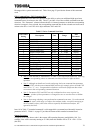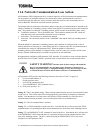
G7 ASD Multi-Protocol Communication Option and PG Feedback Option Manual
71
Status Word
Bit-mapped ASD status word. Table 14 on page 26 provides the format of this status word.
F841 Status Data / F842 Status Data
Via ASD parameters F841 and F842, the user has the ability to select two additional high-speed scan
status items to be read from the ASD. Starting on page 27 of this manual, Table 15, Table 16, Table 17
and Table 18 provide a list of the available status scan data selections and related supporting
information. Once selected, the corresponding status data can be read from the drive via AC/DC drive
object attributes #112 and #113.
Universal Register / Universal Data
These attributes provide direct network access to any internal drive data (configuration parameters,
command data or status data). To use this powerful feature, just set the Universal Register attribute to
the ASD register (also referred to as a “communication number”) that you wish to access, and then
perform the desired operation (“Get” to read from the ASD register or “Set” to write to it) on the
Universal Data attribute. The operation on the Universal Data attribute will be directly performed on
the data value contained in the internal drive register indicated by the Universal Register attribute.
Note that data written to or read from the drive is raw data, which is to say that no scaling (multiplier) is
applied, and all data is expressed as integer values. Also note that the Set service will invoke a
corresponding write request to the drive’s internal nonvolatile EEPROM memory, so that written values
will be retained by the drive through power-off cycles.
Refer to the
Toshiba Series 7 Serial Communications Interface Manual
for detailed information on
available drive registers, their allowable adjustment ranges, and any scaling factors that may apply.
To demonstrate an example operation, let’s say we would like to write a value of 85.00Hz to ASD
parameter “Maximum Frequency” over DeviceNet via an explicit messaging transaction. The ASD
register (communication number) for Maximum Frequency is 0011, which is a value of 0x0011 in
hexadecimal or 17 in decimal. Therefore, we would Set the Universal Register attribute to 17
10
(0x0011). The Maximum Frequency register also has a scaling factor of 0.01Hz associated with it,
which means the value that must be written to this register is 85.00Hz / 0.01Hz = 8500
10
(0x2134).
Therefore, all we need to do now is perform a Set service on the Universal Data attribute with a value of
8500
10
. In this same manner, any available ASD data can be accessed.
If the requested operation cannot be performed (typically due to such reasons as a non-existent ASD
register being targeted, a data value that is out of range, or a Set (write) operation that is performed
when the drive is running targeting a register that does not allow such action), a corresponding
DeviceNet error code will be returned.


















